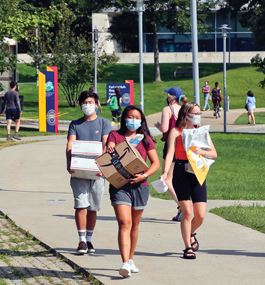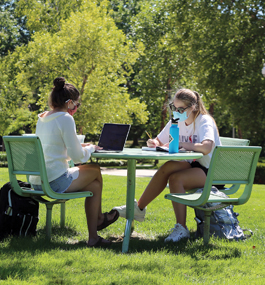The Campus Returns to Life — at a Safe Distance
After the shift to remote studies in the spring, Brandeis welcomed students back for the fall semester, with stringent protocols in place.

Mike Lovett
Soon after the coronavirus pandemic sent most students home and brought campus life to a near standstill in mid-March, faculty and staff began the enormous task of planning for a fall semester that had no precedent.
At President Ron Liebowitz’s request, Provost Lisa Lynch and Stew Uretsky, executive vice president for finance and administration, convened a COVID-19 task force, composed of eight working groups, to consider all possible operational scenarios for the fall. More than 100 faculty, staff and students participated in the task force’s efforts.
On June 30, Liebowitz announced in a community message, “Although the upcoming semester will look unlike any other in our institution’s 72-year history, I am confident that our plans will enable the Brandeis community to work, teach, and learn safely in the face of the risks presented by the COVID-19 pandemic.”
Most undergraduate courses would be held online or in a hybrid format, Liebowitz said, with some in-person components for students living on or near campus. Graduate school classes would also be held in a hybrid format.
Liebowitz’s message was accompanied by the launch of a university website, Plans for Fall 2020, which laid out the contours of the fall semester and answered dozens of evolving FAQs on health and safety protocols, teaching and learning, and residential life.
Meanwhile, during a summer marked by innumerable video meetings (Brandeis owns 7,200 professional Zoom accounts), Academic Services, the Center for Teaching and Learning, Facilities, Community Living and virtually every other administrative office dove into the nitty-gritty of making the fall campus experience as welcoming and community-focused as possible during a pandemic. The phrase “social solidarity” helped guide decisions around making the semester both vibrant and safe.
On Aug. 5, dean of students Jamele Adams and Orientation Leaders hosted This Is Our House over Zoom. The annual event, an evening filled with slam poetry, school spirit and reflections on social justice, usually takes place in Spingold Theater.
“Regardless of where you are — regardless of whether this time for you is good morning, good afternoon or good night — to every student, loved one and friend present, all genders, all pronouns in this space, we say welcome,” Adams said. “Welcome. It is Brandeis o’clock.”
A few days later, the university mandated high-frequency COVID-19 asymptomatic community testing, conducted in partnership with the Broad Institute, a research center based in Cambridge, Massachusetts. Results from the test, which analyzes swab samples taken from the lower nasal passage, are available in 12-48 hours. Health officials estimate Brandeis will administer 90,000 tests by the end of the semester.
At the same time, the Brandeis Community Tracing Program, through which a team of contact tracers identify close contacts of individuals who test positive for the disease, was put in place.
In addition to testing and contact tracing, Brandeis implemented mandatory online COVID training and launched an online health-assessment tool that everyone on campus or coming to campus must fill out every day before arriving on campus or participating in campus activities.
Move-In Day — typically a day of joy and tears, hugging, and crowded stairwells — gave way to a staggered, highly choreographed arrival for students, who began coming to campus in small waves in early August. Classes began on Aug. 26, a week earlier than usual this year.
In mid-August, Brandeis launched its COVID-19 dashboard, updated each weekday to report campus, countywide and statewide testing data, including the number of tests collected and the number of positive tests on campus, along with isolation and quarantine figures, broken down by student and faculty/staff populations.
From the thousands of signs reminding everyone to stay safe to the thousands of COVID-19 tests collected weekly, it’s a different campus this semester. For starters, there are only 1,841 students on campus, roughly one-third the usual number, including 767 students from the Class of 2024, almost all housed in single rooms.
Campus Operations and Facilities Services installed hundreds of Plexiglas barriers and assigned-seating stickers. Fifty social-distancing circles were drawn on the lawns outside Massell and North Quad, and on Chapels Field. Six hundred red-arrow stickers on floors point the way to testing sites, and hundreds of additional signs detail Massachusetts room-occupancy and elevator-occupancy limits.

Mike Lovett
page 2 of 2
Thirty-nine classrooms are being used for hybrid and in-person learning, along with eight furnished tents used as learning or dining space. Crews have removed more than 3,000 pieces of furniture throughout campus to de-densify buildings. Over the summer, engineers assessed campus buildings to confirm that heating and cooling systems are working as designed, and identify measures for increasing outside air to improve air circulation and quality.
This fall, Brandeis welcomed 34 new full-time faculty members and postdoctoral fellows to 24 departments and areas of study in the School of Arts and Sciences, the Heller School for Social Policy and Management, and Brandeis International Business School. Not all of the new faculty physically arrived on campus for the semester.
“The newest members of our faculty are joining our community under unusual and challenging circumstances, but that does not change the fact that they bring exceptional scholarship and expertise with them,” said Lynch in announcing their arrival.
Teaching and learning isn’t the only area that required significant re-imagining to bring campus back to life. Brandeis fall and winter varsity-sports teams, as well as club-sports teams, are not participating in intercollegiate competition this semester, and intramural sports programming has suspended all team-based contact activities.
The men’s and women’s cross-country and track teams meet three times a week in groups of no more than 10 people. Says men’s team captain Josh Lombardo ’21, “There’s no competitive atmosphere right now — hopefully that comes back at some point — but just the camaraderie of going on runs and doing workouts with the team and coach makes this time seem more normal.”
In mid-September, campus religious life rose to the spirit of the moment during the Jewish High Holidays. Hundreds of students attended more than 30 staggered in-person services on campus, held in tents for 25 students at a time. Hillel also distributed hundreds of kosher meal kits; care packages; and picnic blankets, to encourage students to enjoy meals outside.
The Rose Art Museum, shuttered since mid-March, reopened to the campus community at the end of September, with physical distancing and other health measures in place. Shows include an exhibition of works by artist Dora García and a selection of the museum’s most recent acquisitions.
The pandemic hasn’t dampened the campus’s small-d democratic spirit. VoteDeis, a nonpartisan campus coalition supporting voter registration and voting, was in full swing during the weeks before the November election.
“I’ve been interested in politics for as long as I can remember, but this election has taken it to a new level,” says Eliza Welty ’22, BrandeisDems club leader. “It’s important for young people to vote and have their voices heard.”
In October, Brandeis announced the first day of spring-semester classes would be Feb. 1.
Given the university’s flexibility and creativity throughout the fall semester, it’s easy to see why Liebowitz believes the university will emerge from the pandemic “as a more resilient and proud institution,” thanks to its “resourcefulness and intense commitment to the academic enterprise.”
